The automotive market is a battleground for hatchbacks, with competing models vying for the attention of consumers. In this article, we will compare two popular choices in this segment: the BMW 1er Reihe and the Ford Focus. Both cars boast unique features, impressive technology, and appealing designs. Let's delve into the technical aspects, innovations, and overall driving experience offered by these two contenders.
BMW 1 Series vs Ford Focus – Which model is better for everyday use?
Two cars, one duel: BMW 1 Series meets Ford Focus.
Which one wins in performance, efficiency and value for money? Find out now!
Design and Building Quality
The BMW 1er Reihe is a stunning hatchback that embodies the signature BMW design language. With its aggressive stance, well-defined lines, and iconic kidney grille, it appeals to drivers looking for a premium feel. Measuring 4361 mm in length, 1800 mm in width, and 1459 mm in height, it is tailored to provide a sporty yet comfortable driving experience.
On the other hand, the Ford Focus emphasizes a more practical and functional hatchback design. Slightly longer at varying lengths from 4382 mm to 4397 mm and wider at 1825 to 1844 mm, the Focus is built to maximize interior space and comfort. While not as upscale as the BMW, the Focus's design complements its user-friendly features.
Engine Options and Performance
The 2024 BMW 1er Reihe offers an extensive range of engines, including both petrol and diesel options. The petrol models come with power outputs ranging from 122 HP to an exhilarating 300 HP, thanks to the MHEV technology. With two transmission options—the Dual-Clutch Automatic that allows for seamless gear shifts and a traditional automatic variant—drivers can choose a setup that suits their preferences. Notably, the acceleration time can be as quick as 4.9 seconds for the high-performance variant, making it a thrill to drive.
In contrast, the Ford Focus provides a selection of petrol and diesel engines, with power ranging from 115 HP to 280 HP. The manual and automatic gearbox options give users flexibility based on their driving style. Although the top tier engine allows for impressive performance, the Focus generally lags behind the 1er Reihe in acceleration, as the quickest Focus variant reaches 0-100 km/h in a commendable 5.7 seconds—still noteworthy, but not quite as frantic as BMW's offering.
Fuel Efficiency and Environmental Impact
When it comes to fuel consumption, the BMW 1er Reihe excels with several models achieving fuel efficiency as low as 4.3 L/100km, thanks to advanced engineering and efficiency-focused technologies. This commitment serves the dual purpose of delivering a sporty driving experience while maintaining lower emissions, exemplified by CO2 figures ranging from 112 to 173 g/km, depending on the configuration.
The Ford Focus, while slightly less efficient, offers competitive figures with consumption rates between 4.9 and 8 L/100km. The Focus’s CO2 emissions range from 117 to 183 g/km, indicating that while it may not boast the same level of efficiency as the BMW, it remains a responsible choice for eco-conscious consumers.
Interior Comfort and Technology
Inside the 1er Reihe, luxurious materials, high-tech displays, and an intuitive layout define the driving experience. With trunk capacity reaching a functional 300 to 380 liters and ample seating for five, the interior is both stylish and practical. Enhanced with BMW’s advanced infotainment system and driving assistance features, it elevates the user's experience.
The Ford Focus places an emphasis on user-friendly technology and practical interior space, offering trunk capacity slightly better at 392 liters across varying models. Its straightforward infotainment interface and available driver assistance features make it a commendable option for families or those who prioritize usability.
Conclusion: Choosing the Right Hatchback
Choosing between the BMW 1er Reihe and the Ford Focus boils down to personal preference, brand loyalty, and intended use. If you prioritize performance, luxury, and advanced technology, the BMW 1er Reihe stands out as a compelling choice with its robust engine lineup and premium features. Alternatively, the Ford Focus offers excellent value and practicality, catering to those in search of a reliable hatchback with efficient performance.
Ultimately, both models have their unique merits, ensuring that consumers in the hatchback segment are well-covered regardless of their preferences.
Here’s where it gets real: The technical differences in detail
Costs and Efficiency:
Price and efficiency are often the first things buyers look at. Here it becomes clear which model has the long-term edge – whether at the pump, the plug, or in purchase price.
Ford Focus has a slight advantage in terms of price – it starts at 27500 £, while the BMW 1 Series costs 28200 £. That’s a price difference of around 686 £.
Fuel consumption also shows a difference: BMW 1 Series manages with 4.30 L and is therefore a bit more efficient than the Ford Focus with 4.90 L. The difference is about 0.60 L per 100 km.
Engine and Performance:
Under the bonnet, it becomes clear which model is tuned for sportiness and which one takes the lead when you hit the accelerator.
When it comes to engine power, the BMW 1 Series has a hardly perceptible edge – offering 300 HP compared to 280 HP. That’s roughly 20 HP more horsepower.
In acceleration from 0 to 100 km/h, the BMW 1 Series is to a small extent quicker – completing the sprint in 4.90 s, while the Ford Focus takes 5.70 s. That’s about 0.80 s faster.
There’s no difference in top speed – both reach 250 km/h.
There’s also a difference in torque: Ford Focus pulls hardly perceptible stronger with 420 Nm compared to 400 Nm. That’s about 20 Nm difference.
Space and Everyday Use:
Cabin size, boot volume and payload all play a role in everyday practicality. Here, comfort and flexibility make the difference.
Both vehicles offer seating for 5 people.
In curb weight, Ford Focus is to a small extent lighter – 1330 kg compared to 1465 kg. The difference is around 135 kg.
In terms of boot space, the Ford Focus offers minimal more room – 392 L compared to 380 L. That’s a difference of about 12 L.
In maximum load capacity, the Ford Focus performs slightly better – up to 1354 L, which is about 154 L more than the BMW 1 Series.
When it comes to payload, Ford Focus barely noticeable takes the win – 560 kg compared to 510 kg. That’s a difference of about 50 kg.
Who wins the race?
The Ford Focus proves to be has a very small edge and therefore becomes our DriveDuel Champion!
Ford Focus is the better all-rounder in this comparison.

Ford Focus
BMW 1 Series
The BMW 1 Series stands out with its dynamic design that embodies both elegance and sportiness, making it an attractive choice for urban driving. Its interior offers a premium feel, combining quality materials with the latest in technological features to enhance comfort and connect drivers. Under the bonnet, a range of efficient engines ensures a responsive and enjoyable driving experience, balancing power with practicality.
details @ press.bmwgroup.com
@ press.bmwgroup.com
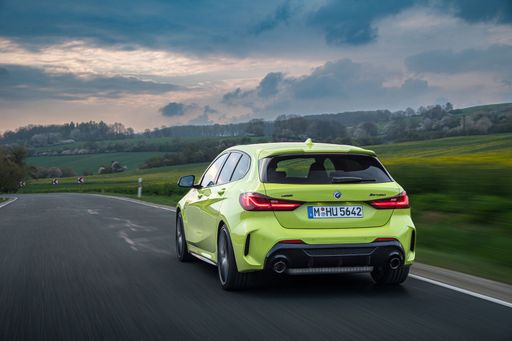 @ press.bmwgroup.com
@ press.bmwgroup.com
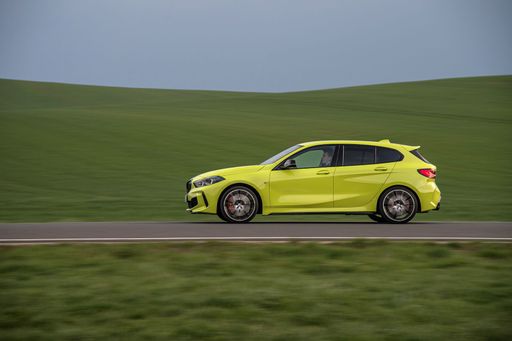 @ press.bmwgroup.com
@ press.bmwgroup.com
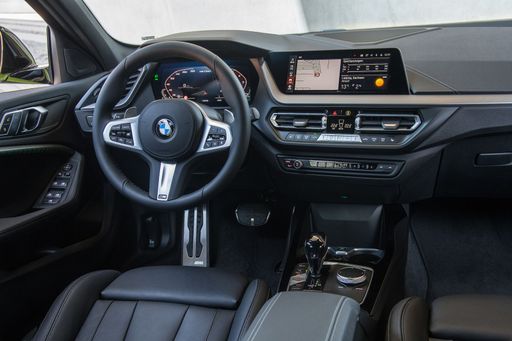 @ press.bmwgroup.com
@ press.bmwgroup.com
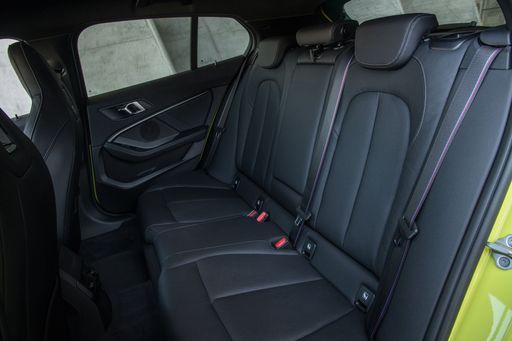 @ press.bmwgroup.com
@ press.bmwgroup.com
Ford Focus
The Ford Focus is celebrated for its agile handling and stylish design, making it a popular choice among hatchback enthusiasts. Its well-crafted interior offers a comfortable driving experience with intuitive technology features. Whether navigating city streets or cruising on the motorway, the Ford Focus delivers a balanced drive with impressive efficiency.
details @ focus.fordpresskits.com
@ focus.fordpresskits.com
 @ focus.fordpresskits.com
@ focus.fordpresskits.com
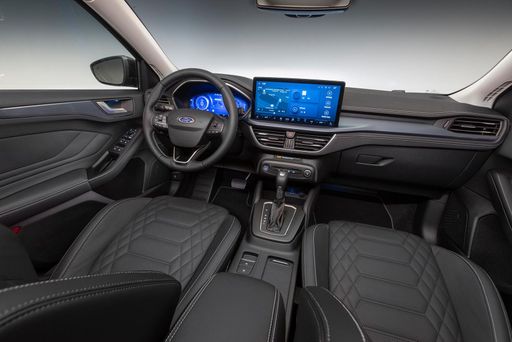 @ focus.fordpresskits.com
@ focus.fordpresskits.com

|

|
|
|
|
Costs and Consumption |
|
|---|---|
|
Price
28200 - 51100 £
|
Price
27500 - 42700 £
|
|
Consumption L/100km
4.3 - 7.6 L
|
Consumption L/100km
4.9 - 8 L
|
|
Consumption kWh/100km
-
|
Consumption kWh/100km
-
|
|
Electric Range
-
|
Electric Range
-
|
|
Battery Capacity
-
|
Battery Capacity
-
|
|
co2
112 - 173 g/km
|
co2
117 - 183 g/km
|
|
Fuel tank capacity
49 L
|
Fuel tank capacity
52 L
|
Dimensions and Body |
|
|---|---|
|
Body Type
Hatchback
|
Body Type
Hatchback
|
|
Seats
5
|
Seats
5
|
|
Doors
5
|
Doors
5
|
|
Curb weight
1465 - 1625 kg
|
Curb weight
1330 - 1529 kg
|
|
Trunk capacity
300 - 380 L
|
Trunk capacity
392 L
|
|
Length
4361 mm
|
Length
4382 - 4397 mm
|
|
Width
1800 mm
|
Width
1825 - 1844 mm
|
|
Height
1459 mm
|
Height
1438 - 1482 mm
|
|
Max trunk capacity
1135 - 1200 L
|
Max trunk capacity
1354 L
|
|
Payload
475 - 510 kg
|
Payload
495 - 560 kg
|
Engine and Performance |
|
|---|---|
|
Engine Type
Diesel, Petrol MHEV, Diesel MHEV, Petrol
|
Engine Type
Petrol MHEV, Diesel, Petrol
|
|
Transmission
Automatic
|
Transmission
Manuel, Automatic
|
|
Transmission Detail
Dual-Clutch Automatic
|
Transmission Detail
Manual Gearbox, Dual-Clutch Automatic, Automatic Gearbox
|
|
Drive Type
Front-Wheel Drive, All-Wheel Drive
|
Drive Type
Front-Wheel Drive
|
|
Power HP
122 - 300 HP
|
Power HP
115 - 280 HP
|
|
Acceleration 0-100km/h
4.9 - 9.8 s
|
Acceleration 0-100km/h
5.7 - 11.8 s
|
|
Max Speed
210 - 250 km/h
|
Max Speed
186 - 250 km/h
|
|
Torque
230 - 400 Nm
|
Torque
170 - 420 Nm
|
|
Number of Cylinders
3 - 4
|
Number of Cylinders
3 - 4
|
|
Power kW
90 - 221 kW
|
Power kW
85 - 206 kW
|
|
Engine capacity
1499 - 1998 cm3
|
Engine capacity
999 - 2261 cm3
|
General |
|
|---|---|
|
Model Year
2024
|
Model Year
2022 - 2024
|
|
CO2 Efficiency Class
D, C, F
|
CO2 Efficiency Class
D, G
|
|
Brand
BMW
|
Brand
Ford
|
What drive types are available for the BMW 1 Series?
The BMW 1 Series is offered with Front-Wheel Drive or All-Wheel Drive.
The prices and data displayed are estimates based on German list prices and may vary by country. This information is not legally binding.
